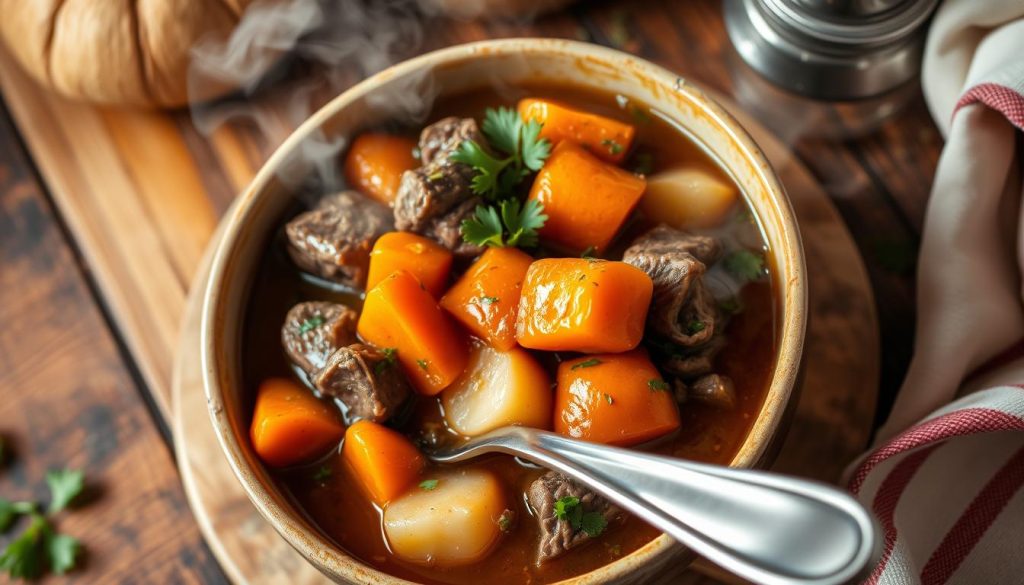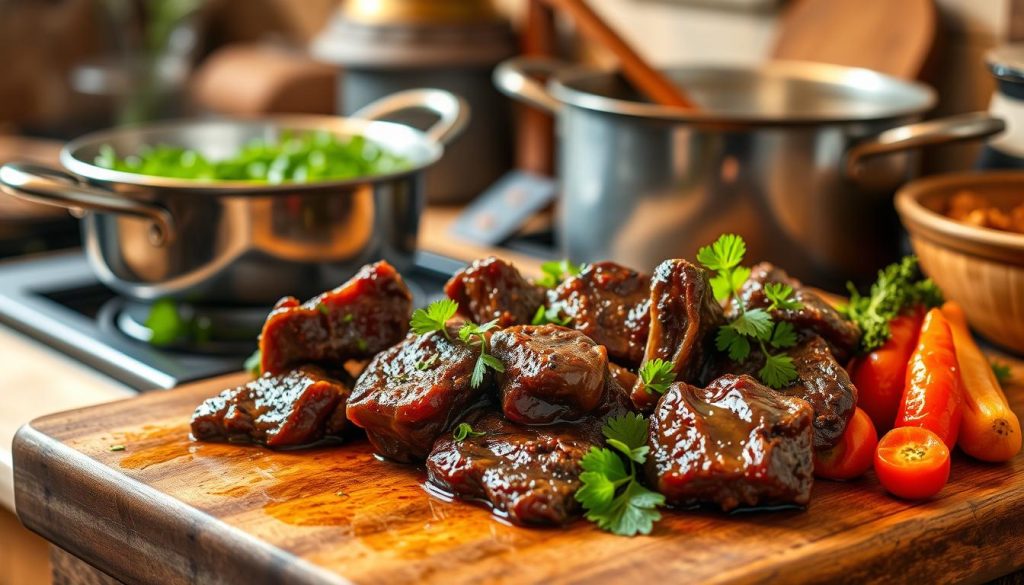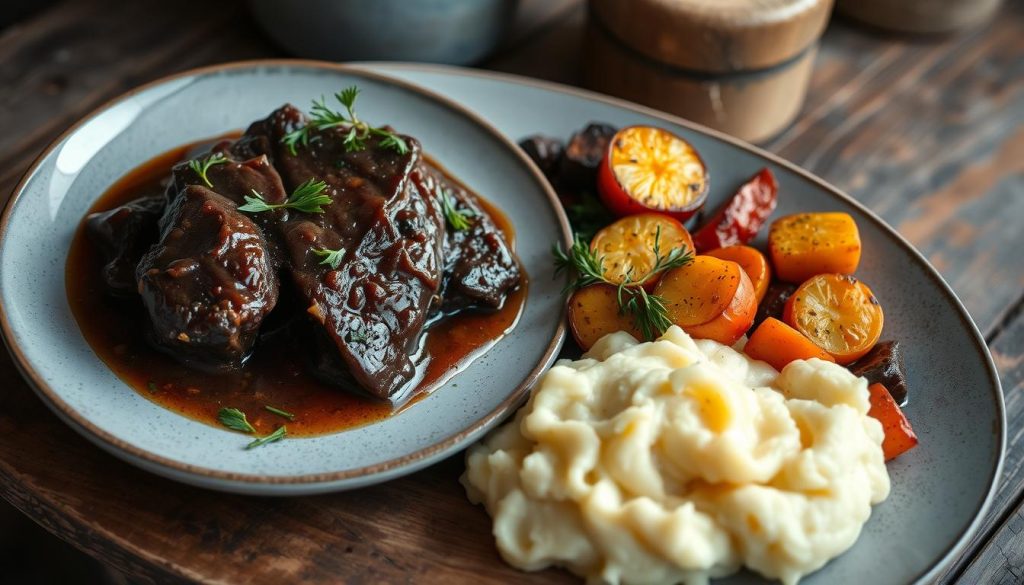Exploring beef cheek meat reveals its rich flavor and tender texture. It’s perfect for many dishes. Slow-cooking makes it incredibly tender, so it just falls apart.
Beef cheek🍖meat is loved by chefs and home cooks for its versatility and flavor. It’s great for trying new recipes or experimenting with cooking methods. Slow-cooked or tender, the options are endless.
- You can achieve tender beef cheek through slow-cooking methods.
- Beef cheek meat is versatile and can be used in a variety of dishes.
- Slow-cooked beef cheek is a popular choice among chefs and home cooks.
- Beef cheek meat is known for its rich flavor and tender texture.
- Cooking techniques can greatly impact the tenderness of beef cheek meat.
- Beef cheek meat is a great option for those looking to try new recipes.
What is Beef Cheek Meat?
Beef cheek meat is a special cut of beef that stands out. It’s not just tasty but also full of nutrients. You can make a variety of dishes with it, like stews and tacos.
This meat comes from the cow’s face. It’s often overlooked but perfect for slow cooking. It becomes tender and full of flavor. Plus, it’s packed with protein, vitamins, and minerals, making it healthy.
Anatomical Location and Properties
Beef cheek meat comes from the cow’s jaw muscle. This muscle is dense, making it great for slow cooking. It’s perfect for recipes like braising or stewing.
Nutritional Profile
A 3-ounce serving of beef cheek meat has about 22 grams of protein. It also has 15 grams of fat and no carbs. It’s full of vitamins B12 and B6, and minerals like iron and zinc. This makes it a favorite in many dishes.
Texture and Flavor Characteristics
The meat is tender and juicy, with a deep beef flavor. When cooked slowly, it becomes incredibly tender. Its flavor is rich and savory, making it perfect for tacos and more.

The Rich History of Cooking with Beef Cheeks
Exploring beef🍖cheek meat reveals a long history across centuries and continents. Cooking with beef cheeks has been a tradition passed down through generations. It has shaped various culinary traditions, from European to Latin American.
The unique texture and flavor of beef cheeks make it popular. When cooked slowly, the meat becomes tender and flavorful. This is true for braised beef cheek dishes, where it absorbs deep flavors.
Popular ways to cook beef cheeks include:
- Braising: cooking in liquid over low heat for a long time
- Slow-cooking: using a slow cooker or oven to tenderize the meat
- Stewing: cooking in a flavorful broth with veggies and spices
Discovering beef cheek🍖meat opens up a world of recipes and techniques. Whether you want a comforting stew or a tender flavorful beef cheek dish, there’s a method for you. Beef cheek meat’s rich history and cultural importance make it an exciting ingredient to explore.
Selecting and Purchasing Quality Beef Cheek Meat
Creating a tasty beef cheek stew starts with the meat. You want a beef cheek that’s tender and soaks up all the stew’s flavors. Knowing what to look for when buying is key.
First, think about the type of beef cheek🍖meat. You can pick from grass-fed or grain-fed. Grass-fed beef cheeks are leaner and taste stronger. Grain-fed ones are softer and milder.
What to Look for When Buying
- Look for beef cheeks with a good balance of fat and lean meat
- Choose options with a fresh, red color
- Check the packaging for any signs of damage or leakage
After picking your beef cheeks, store them right to keep them fresh. Keep them cold, below 40°F (4°C), and use them within a few days.

Where to Find Beef Cheeks
You can find beef cheeks at butcher shops or specialty meat markets. Some supermarkets also have them, in the meat or international foods section. If you can’t find them, try online stores that ship beef cheeks to you.
Essential Preparation Techniques
Working with beef🍖cheek meat requires the right preparation to unlock its rich flavor and tender texture. Start by trimming off any excess fat or connective tissue. This step ensures even cooking.
To make the beef cheek tender, you can marinate, season, or braise it. Marinating adds flavor and tenderizes the meat. Seasoning boosts the natural taste of the beef. Braising cooks the meat in liquid at low heat, making it tender and flavorful.
Important steps for preparing beef🍖cheek meat include:
- Trimming excess fat and connective tissue
- Marinating or seasoning the meat
- Cooking the meat using low heat and liquid
By following these steps, you can make delicious dishes with beef cheek🍖meat. Whether it’s for a special event or a simple dinner, a tender beef cheek will impress everyone.

Slow-Cooking Methods for Tender Results
Slow-cooking is the best way to make beef cheek tender and flavorful. Braising is a top choice. It cooks the beef in liquid over low heat for a long time. This makes the slow-cooked beef cheek so tender it falls apart easily.
Slow cookers are also great for cooking beef cheek. They let you make a variety of beef cheek recipes with little effort. Just add your ingredients, set the timer, and let the slow cooker work its magic.

Braising Basics
To braise beef🍖cheek, brown the meat on all sides first. Then, cook it in liquid like stock or wine over low heat. This method makes the beef cheek recipes rich and full of flavor.
Slow Cooker Approaches
Slow cookers are perfect for cooking beef cheek. They allow for easy, hands-off cooking. Just add your ingredients, set the timer, and let the slow cooker do the rest.
Pressure Cooking Tips
Pressure cooking is another quick way to cook beef cheek. It’s great for those in a hurry. Using a pressure cooker can cut down cooking time while keeping the meat tender and flavorful.
Popular Beef Cheek Dishes Around the World
Exploring beef cheek meat reveals a variety of dishes. Each one highlights its rich flavor and tender texture. From beef cheek tacos to hearty stews, these dishes show the versatility of this meat.
In many Latin American countries, beef cheek tacos are a favorite. They’re filled with slow-cooked beef cheek, fresh salsa, and warm tortillas.
In other parts of the world, braised beef cheek is a hit. It’s cooked in a rich sauce with veggies and served with crusty bread or over mashed potatoes. Some popular dishes include:
- Beef cheek stew with red wine and mushrooms
- Braised beef cheek with polenta and roasted vegetables
- Beef cheek tacos with sliced avocado and sour cream
These dishes show the diversity of beef cheek meat. It can be paired with many flavors and ingredients. Whether you want something spicy or something comforting, there’s a beef cheek dish for you.
Common Mistakes to Avoid When Cooking Beef Cheeks
When cooking beef cheek meat, paying close attention to detail is key. This ensures tender and flavorful results. Avoiding common mistakes is critical to prevent tough or overcooked meat. Let’s look at some common pitfalls to avoid.
Common mistakes include temperature control issues and seasoning errors. These can make the meat tough or dry. Timing mistakes can also lead to overcooking or undercooking, affecting the texture.
Temperature Control Issues
Temperature control is vital when cooking beef cheeks. High heat can make the meat tough and dry. Low heat can cause uneven cooking. Use a thermometer to monitor the meat’s internal temperature.
Seasoning Errors
Seasoning is important in cooking beef cheeks. Too much salt or pepper can overpower the meat’s flavor. Too little seasoning can make the dish bland. Use a balanced blend of herbs and spices to enhance the flavor.
Timing Miscalculations
Timing is everything when cooking beef cheeks. Overcooking makes the meat tough and dry. Undercooking can make it unsafe. Use a timer and monitor the cooking time carefully. With practice, you can cook tender beef cheeks and enjoy great recipes.
Conclusion: Making the Most of Your Beef Cheek Experience
Beef cheek meat is truly amazing. It has a rich flavor and a tender texture that melts in your mouth. This versatile cut can change your cooking game.
Whether you’re a pro at slow-cooked beef cheek or trying new beef cheek stew recipes, you’ve learned a lot. Your journey with beef cheek has been rewarding.
Keep exploring and experimenting with this ingredient. Remember to choose quality cuts, slow-cook them, and season well. These tips will help you make the most of beef cheek meat and impress everyone.
So, dive into cooking with beef cheeks and let your creativity shine. It’s perfect for any occasion or a cozy night in. Enjoy your culinary adventures with beef cheeks!
Halal Beef: Savory Cuts and Cooking Tips for Delectable Meals
FAQ
What is beef cheek meat?
Beef cheek meat comes from the cow’s cheek muscle. It’s tough but tender and flavorful when cooked right. You can find it on the cow’s lower face, near the jaw.
What are the nutritional benefits of beef cheek meat?
Beef cheek meat is packed with nutrients. It’s rich in protein, iron, and vitamins and minerals. It also has collagen, which is good for your joints and skin.
How does the texture and flavor of beef cheek meat differ from other beef cuts?
Beef cheek meat is tender and juicy when cooked. It tastes richer and more intense than other cuts. Its texture is like short ribs or brisket, melting in your mouth.
What are some popular beef cheek dishes around the world?
Beef cheek is used in many dishes globally. You can find it in tacos, braised, stewed, or in ragu.
What are some tips for selecting and purchasing high-quality beef cheek meat?
Look for deep red, firm beef cheek meat. Avoid dry or discolored cuts. Buy from a trusted butcher for freshness and quality.
What are the best cooking methods for beef cheek meat?
Slow-cooking is best for beef cheek. Try braising, crockpot, or Instant Pot cooking. These methods tenderize the meat, making it flavorful.
What are some common mistakes to avoid when cooking beef cheeks?
Don’t skip trimming or seasoning. Avoid overcooking or undercooking. Monitor the temperature and time closely for tender, juicy beef cheeks.

